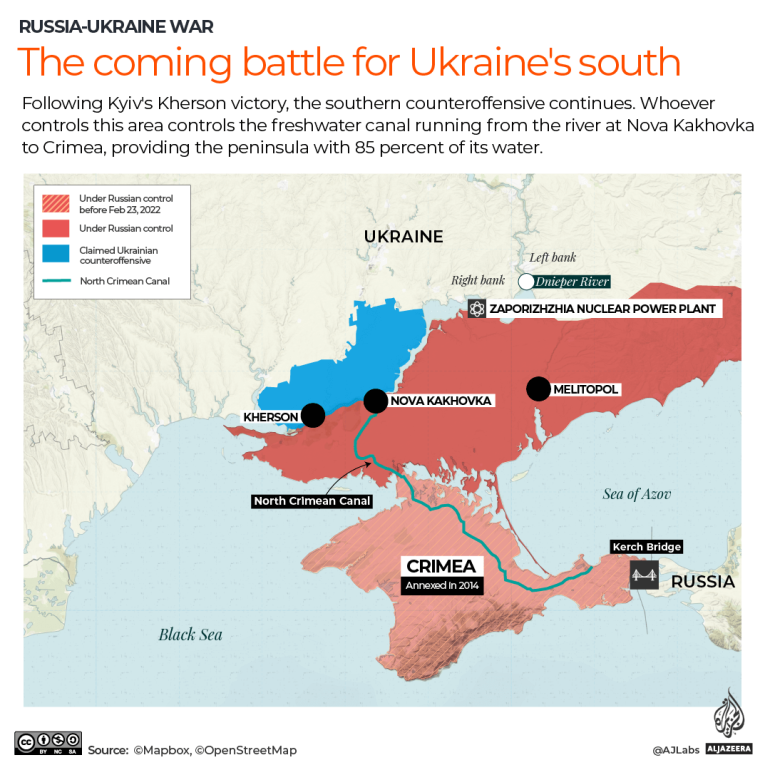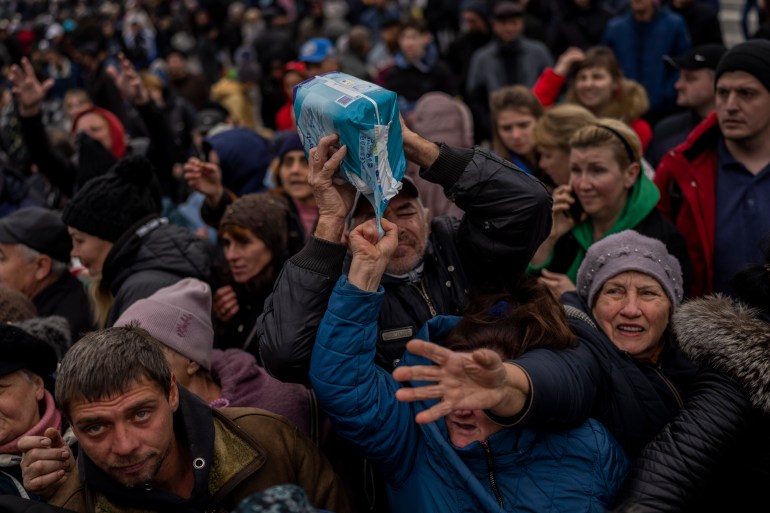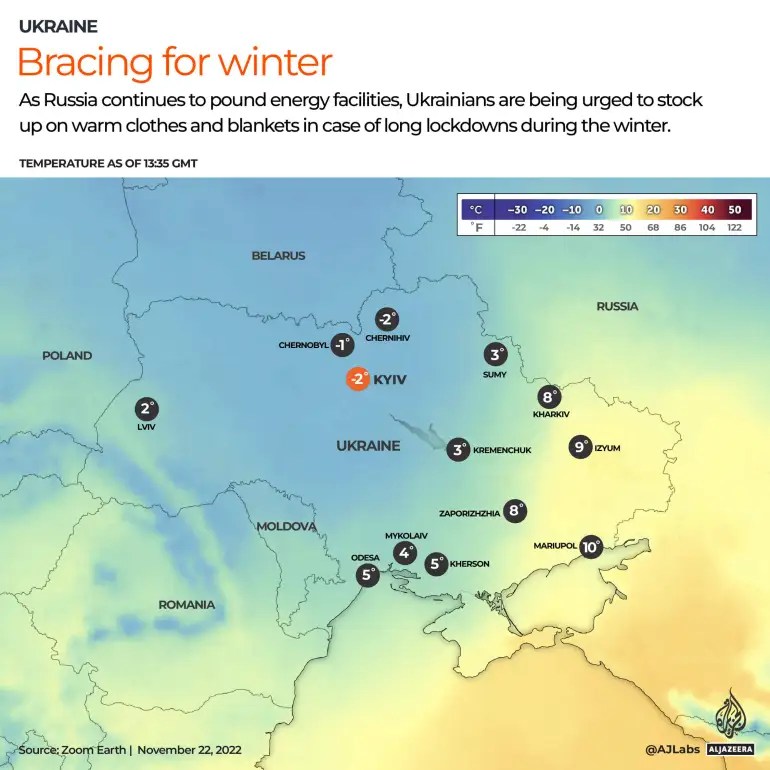Russian forces in Kherson alert as Ukraine plans next move | Russia-Ukraine war News
After recapturing Kherson city, Ukraine kept Russian forces guessing about their next move, pinning down occupying troops in defensive positions and rendering them unavailable for offensive operations.
Some 30,000 Russian troops that withdrew from the west bank of the Dnieper river earlier this month were entrenching themselves in the Zaporizhia and Kherson regions during the 39th week of the war, deputy head of Ukrainian military intelligence Major-General Vadym Skibitskyi, told the Kyiv Post.
“[The Russians] are waiting for our liberation offensive, that’s why they have created a defensive line in Kherson, another on the administrative border of [Kherson and] Crimea, and another in the northern Crimea region,” Skibitskiy said.

“The enemy is on the defensive in the Zaporizhzhia direction,” said Ukraine’s general staff. “In the Kryvyi Rih and Kherson directions, the enemy is creating an echeloned defence system, improving fortification equipment and logistical support of advanced units, and not stopping artillery fire at the positions of our troops and settlements on the right bank of the Dnipro River.”
In announcing the withdrawal from Kherson city on November 9, the Russian commander-in-chief of forces in Ukraine, Alexander Surovikin, had said it would free up manpower to strengthen other fronts.
Russia has been prioritising the occupation of the Luhansk and Donetsk regions in the east, and Russian artillery fruitlessly pounded away at Ukrainian defenders there throughout the week.
Ukraine’s general staff said that continued to be Russia’s plan, but soldiers were resisting it.
“The command of the Russian occupying forces plans to redeploy separate units withdrawn during the retreat from the right bank of the Dnipro River in the Kherson oblast to continue hostilities in the Donetsk and Luhansk oblasts. The mobilised persons, most of whom make up these formations, are very indignant at the prospects of the implementation of the mentioned plans,” they said.
A possible further source of Russian restraint is that Ukraine has made no secret of its intention to take back Crimea, annexed by Russia in 2014.
To get there, it must prevail over the remaining Russian forces in Kherson or Zaporizhia, and Russia appeared to anticipate an attack there.
Skibitskiy said the timing of a counteroffensive in Crimea would depend mainly on the “weapons and munitions” Ukraine would receive from allies, but that once these were in place, troop movements could outmanoeuvre those of Russian forces.
“One area where we have some advantages over the Russian Federation is very quick movement or regrouping of forces,” he said. “For example, during the preparation for [counteroffensive] operations in Kherson region, Russian forces redeployed battalion tactical groups from Kharkiv and Donetsk to Kherson and Zaporizhia for a month,” he said.

“If the Ukrainians continue to fight the methodical, logistically centric war that they have so far, then their next move will probably to try and extend the range of their weapons to fully separate Russian forces into completely unsupported zones,” said Phillips O’Brien, who teaches strategy at the University of St Andrews.
That means driving a wedge through Zaporizhia to the Sea of Azov, cutting off Russian forces in Kherson and Crimea from those in Donetsk and Luhansk, he said.
Despite the mobilisation of 300,000 conscripts in September and October, Russia appears short of manpower – possibly because it cannot adequately equip those forces.
Ukraine’s general staff said Russia was preparing legislation to conscript men in occupied parts of Ukraine next year, and was continuing to recruit prisoners in Russia.
They also said the Wagner group, which is credited with some Russian successes in the Bakhmut area over the past months, was enlisting mercenaries among factory workers in Belgorod.
“According to the agreement with the management of the Oskol electrometallurgical plant, workers of draft age will be involved in military training at the base of the ‘Wagner’ PMC for a period of 30 days with retention of wages … Upon completion, participants will be asked to sign a contract with a private military [unit],” the staff said.
Covert mobilisation was also continuing in Crimea, said the staff.
“In the city of Simferopol, on November 19, a meeting was held with the participation of the so-called heads of ‘law enforcement agencies’ with representatives of the city administration and heads of village councils. The main issue was the non-fulfilment of the determined quantitative indicators of mobilisation. From November 21, representatives of the so-called ‘military commissariats’ and the ‘police’ in the mentioned temporarily occupied territory started handing out summonses.”
Winter as a weapon
Russia has continued its hybrid war against Ukraine’s civilian infrastructure using Iranian drones.
Ten million Ukrainians were left without electricity after dozens of Russian drones and missiles struck energy infrastructure.
The regions of Odesa, Vinnytsia, Sumi and Kyiv were most affected, but on November 23 power outages also spread to neighbouring Moldova.

The World Health Organization warned that these attacks against energy infrastructure mean many Ukrainians face life-threatening situations this winter, when temperatures in parts of the country are forecast to plummet to below 20C (-4F).
Two to three million Ukrainians will have to leave their homes in search of warmer shelter, said Hans Henri P Kluge, WHO regional director for Europe.
“The devastating energy crisis, the deepening mental health emergency, constraints on humanitarian access and the risk of viral infections will make this winter a formidable test for the Ukrainian health system and the Ukrainian people,” Kluge said.
“Russia’s deliberate cruelty only deepens our resolve to uphold Ukraine’s fundamental right to defend itself and defend the rules-based international order,” said US defence secretary Lloyd Austin after chairing the seventh Contact Group of countries donating military aid to Ukraine.
Hours before Russia’s barrage of attacks on Wednesday, in a largely symbolic political move, the European Parliament declared Russia a “state sponsor of terrorism” for these drone attacks, with 494 legislators voting in favour, 58 against and 44 abstaining.
“The deliberate attacks and atrocities carried out by the Russian Federation against the civilian population of Ukraine, the destruction of civilian infrastructure and other serious violations of human rights and international humanitarian law amount to acts of terror,” the resolution said.
Looking ahead, Friday will mark 10 months of war. As the cold sets in, Russian President Putin is hoping Ukraine’s resolve will freeze – an unlikely scenario given the fight so far.

Pingback: คาสิโนออนไลน์ sagame
Pingback: BAU
Pingback: jebjeed888
Pingback: a knockout post
Pingback: continue reading this
Pingback: pg168
Pingback: click here to read
Pingback: Buy Ozempic for weight loss usa